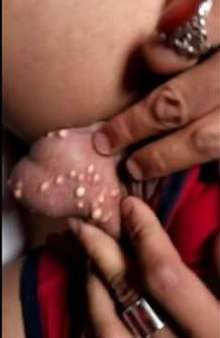Steatocystoma multiplex
Steatocystoma multiplex, is a benign, autosomal dominant congenital condition resulting in multiple cysts on a person's body. Steatocystoma simplex is the solitary counterpart to steatocystoma multiplex.[2]
| Steatocystoma multiplex | |
|---|---|
| Other names | Epidermal polycystic disease and Sebocystomatosis[1]:781 |
| Specialty | Dermatology |
Causes

It is associated with defects in Keratin 17.[3] The condition is inherited in an autosomal dominant manner. This indicates that the defective gene responsible for a disorder is located on an autosome, and only one copy of the defective gene is sufficient to cause the disorder, when inherited from a parent who has the disorder.
However, a solitary case can also emerge in a family with no prior history of the disorder due to the occurrence of a mutation (often referred to as a sporadic or spontaneous mutation).
Diagnosis
Treatment
The cysts can be removed via excision, though conventional cyst excision techniques have proven impractical, and a specialized regimen is required.[4]
See also
References
- Freedberg, et al. (2003). Fitzpatrick's Dermatology in General Medicine. (6th ed.). McGraw-Hill. ISBN 0-07-138076-0.
- Davey, Mathew. "Steatocystoma Multiplex". Retrieved 25 May 2011.
- Smith FJ, Corden LD, Rugg EL, et al. (1997). "Missense mutations in keratin 17 cause either pachyonychia congenita type 2 or a phenotype resembling steatocystoma multiplex". J. Invest. Dermatol. 108 (2): 220–3. doi:10.1111/1523-1747.ep12335315. PMID 9008238.
- Pamoukian VN, Westreich M (1997). "Five generations with steatocystoma multiplex congenita: a treatment regimen". Plast. Reconstr. Surg. 99 (4): 1142–6. doi:10.1097/00006534-199704000-00036. PMID 9091916.
External links
| Classification | |
|---|---|
| External resources |